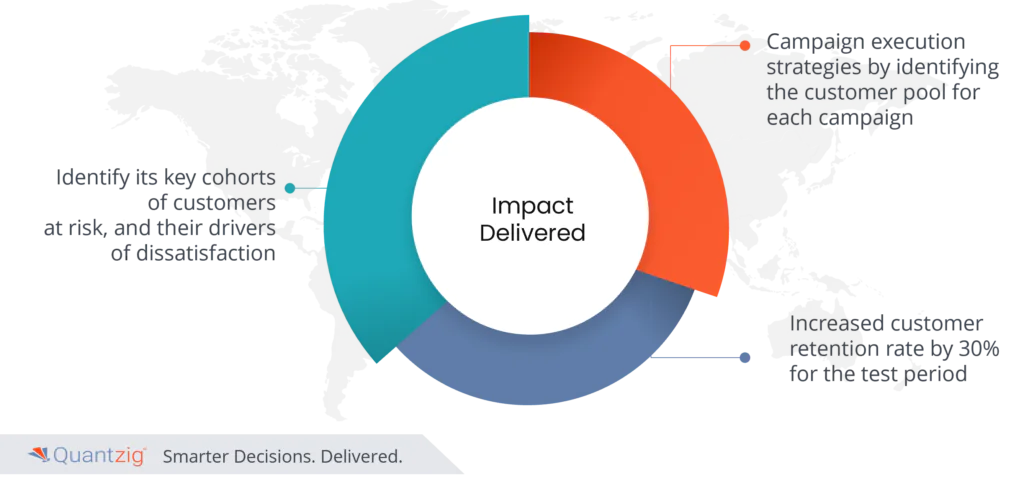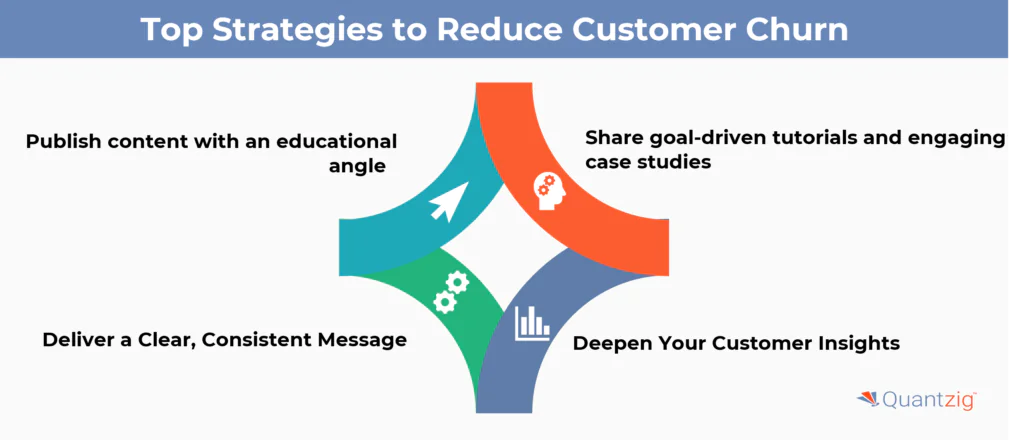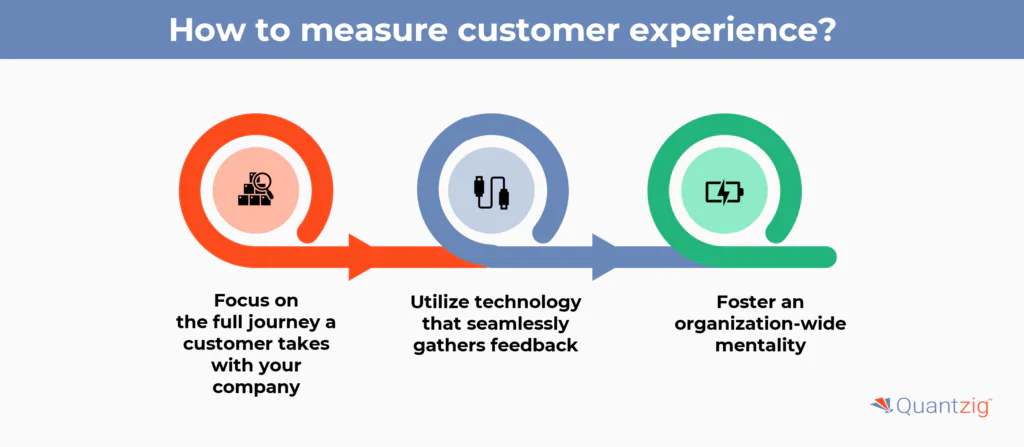Written By: Sudeshna Ghosh
Table of Contents
Key Takeaways for Customer Experience in Marketing
- Quantzig’s advanced Customer 360 Datamart helped a multinational Telecom brand to identify its key cohorts of customers at risk, and their drivers of dissatisfaction, and experience an increased customer retention rate by 30% for the test period.
- Investing in a customer-focused business approach requires commitment from both executives and employees to be successful. Customer experiences are disjointed, and their motivations get misunderstood when data is disconnected. This leads to incorrect assumptions and irrelevant actions that do not address actual needs.
- Quantzig’s customized customer experience and user experience improvement system brings together various omnichannel data points and details about the customer journey. This allows us to pinpoint factors affecting the customer experience and understand cause and effect relationships.
Introduction
The COVID-19 pandemic presented a challenge for companies to continue providing quality customer experience during a time of crisis. However, many businesses adapted well to customers’ changing priorities around safety, security, and convenience. For instance, online retailers and food delivery services quickly implemented contactless delivery methods to protect customers and employees as the virus spread. This shows how some companies were able to pivot their customer service approach to address top concerns during the public health emergency. The pandemic tested companies’ agility in meeting customers’ most pressing needs under difficult circumstances.
Customer Experience Marketing encapsulates everything that businesses do to put their customers first, manage their journeys, and serve their needs. This case study will give you an in-depth insight into how Quantzig’s advanced Customer 360 Datamart helped a multinational Telecom brand to experience an increased customer retention rate by 30% for the test period.
Book a demo to experience the meaningful insights we derive from data through our analytical tools and platform capabilities. Schedule a demo today!
Request a Free DemoQuantzig’s Customer Experience in Marketing Solution for a CPG Brand
| Client Details | A multinational Telecom brand headquartered in Europe with annual revenue of $10bn+. |
| Challenges Faced by The Client | Their e-commerce team was looking for a solution that could help them identify transactional customers with low propensities and at risk for retention initiatives. |
| Solutions Offered by Quantzig | We started by constructing a customer 360 Datamart using demographic, transactional, channel, and behavioral data. We then singled out customers with higher risks and the attributes causing dissatisfaction or inadequate brand engagement through churn prediction and retention modeling. Additionally, we suggested retention plans and win-back tactics for segments and channels to assist the client in formulating win-back strategies. |
| Impact Delivered | 1. We helped identify its key cohorts of customers at risk, and their drivers of dissatisfaction and enabled systematic retargeting. 2. We also continue to help them with campaign execution strategies by identifying the customer pool for each campaign, messaging insights for the campaign plan, and performance measurement of campaigns to measure uplifts. 3. Increased customer retention rate by 30% for the test period. |
Client Details
A multinational Telecom brand headquartered in Europe with annual revenue of $10bn+.
Challenges in Customer Experience Marketing Tactics Faced by the Client
Their e-commerce team was looking for a solution that could help them identify transactional customers with low propensities and at risk for retention initiatives.
Customer Experience Marketing Tactics Offered by Quantzig for the Client:
We started by constructing a customer 360 Datamart using demographic, transactional, channel, and behavioral data. We pinpointed all potential attributes that could influence customer satisfaction and brand loyalty. We then singled out customers with higher risks and the attributes causing dissatisfaction or inadequate brand engagement through churn prediction and retention modeling. Additionally, we suggested retention plans and win-back tactics for segments and channels to assist the client in formulating win-back strategies.
Impact Delivered using Quantzig’s Expertise:
- We helped identify its key cohorts of customers at risk, and their drivers of dissatisfaction and enabled systematic retargeting.
- We also continue to help them with campaign execution strategies by identifying the customer pool for each campaign, messaging insights for the campaign plan, and performance measurement of campaigns to measure uplifts.
- Increased customer retention rate by 30% for the test period.
Also Read: Maximizing Marketing Budgets with Campaign ROI Analysis
Get started with your complimentary trial today and delve into our platform without any obligations. Explore our wide range of customized, consumption driven analytical solutions services built across the analytical maturity levels.
Start your Free Trial TodayWhat Is Customer Experience Marketing?
Customer experience marketing (CEM or CXM) adopts a strategic method that concentrates on forging positive, memorable engagements for customers during their whole journeys with a particular brand.
Dissimilar from traditional marketing, which frequently revolves around endorsing goods or services, customer experience marketing delves further into the rapport between a brand and its buyers, to accomplish allegiance and customer endorsement.
Numerous marketing units only spotlight procuring new purchasers. This tactic is unproductive since obtaining expenses persists in ascending.
Importance of Customer Experience in Marketing
Leading brands achieve and maintain their position in the market by providing superior customer experiences tailored to each individual at every touchpoint in their relationship with the brand. Effective management of the customer experience allows the marketing team to address risks and opportunities in customer journeys, succeeding in key moments that matter to the customer. Customer experience analytics can provide intelligence, decision support, and recommendations for the next best action, reducing the need for manual oversight and scaling operations. This makes it easier for a company to track, manage, and execute customer engagement strategies.
What are the Potential Challenges of Implementing Customer Experience in Marketing?
Investing in a customer-focused business strategy requires commitment from both executives and employees to be successful. Customer experiences are often disjointed, and their motivations can become unclear when data is fragmented, leading to false assumptions and irrelevant actions that don’t address real needs.
What are the Key Benefits of Quantzig’s Customer Experience in Marketing Tactics for Organizations?
Our framework for optimizing customer and user experience analyzes data from diverse sources including customer satisfaction surveys, Net Promoter Score (NPS), Customer Effort Score, touchpoint interactions, and feedback, voice of the customer, customer journey data like foot traffic and transactions, and commercial performance. This enables us to identify factors influencing CX (customer experience) and uncover causal relationships, empowering CX specialists with control levers to tweak for better customer outcomes and ROI.
We start with experience-based segmentation of customers, then identify risks and opportunities at both the touchpoint and individual levels, and finally determine activation strategies and the next best actions.
Unlike off-the-shelf CX/UX solutions, ours are bespoke, tailored, and co-created with clients for greater actionability, intelligence, and futureproofing aligned to their enterprise roadmaps. We provide various consumption methods from simulations, testing, and workbenches to fully automated next-best action engines, suiting different user needs and process integration.
Why should Marketing and Customer Service Work Together?
Marketing and customer service can work together to improve customer retention and loyalty. Marketing can use insights from customer service to create campaigns that address common customer problems or promote loyalty programs. Meanwhile, customer service can use marketing materials to give better support and recommend additional products and services in a way that provides value to the customer. By coordinating efforts, marketing and customer service can enhance the overall customer experience, build loyalty, and drive retention.
Customer service has a pulse on how shifts in the market impact how customers see things and act. This real-time insight allows marketing to rapidly modify promotions and messaging to respond to these shifts. The core ideas and flow are maintained while using different phrasing.
Also Read: Track Business Progress with Marketing Analytics Dashboard
Experience the advantages firsthand by testing a customized complimentary pilot designed to address your specific requirements. Pilot studies are non-committal in nature.
Request a Free PilotTop Strategies to Reduce Customer Churn
Your brand can take advantage of CX marketing in several ways. There are straightforward yet powerful marketing techniques you can use to provide customers with a great experience. Let’s examine some of these easy-to-implement but highly effective strategies for boosting customer satisfaction through CX (customer experience) marketing initiatives.
1. Publish content with an educational angle
Excellent customer experience relies on a high degree of confidence in using your product. The initial place people look for assistance is through Google searches (regardless of whether you want to acknowledge this or not!). Rather than resisting it, take advantage of the organic traffic that already exists there.
Keep in mind, that customers desire more than just learning how to execute fundamental tasks with your product. Surpass customer expectations by demonstrating how they can enhance the way they live and work so that they genuinely anticipate utilizing your product or service.
2. Share goal-driven tutorials and engaging case studies
Support articles should not just cover the fundamentals. Enhance your customer service by making the goal of helping content more ambitious. Highlighting particular results or sectors brings in more users to take in the material.
Examples of success can also motivate your buyers to get more out of your offering. Explaining how your business assisted other consumers or patrons can be an outstanding technique to prod those still researching to take the next step.
3. Deliver a Clear, Consistent Message
Content marketing is an important part of supporting your customers. Customers often have questions about what your product can do throughout their relationship with your company. Marketing materials can answer these questions before someone even becomes a sales lead.
You should design your marketing campaigns to communicate clear, reliable messages. Customers need to understand what your product or service is meant to accomplish. If you have a promotion, explain clearly how the sale works. When launching a new product, outline the benefits so they are easy to grasp. If starting a loyalty program, make joining, earning points, and redeeming rewards straightforward for your audience.
4. Deepen Your Customer Insights
Grasping who your customers are is crucial for making the most informed business choices. Moreover, consistently polling customers will reveal hazards and tackle them sooner.
Examine the contrasts in encounters and mentalities between respondent gatherings after some time. Break down what causes this distinction and conclude how to close the hole.
When you have your client information, focus on enhancements. One model is reexamining content in your information base if it drives objections. Similarly, retailers can likewise address holes in client support processes or formats.
How to measure customer experience?
It may seem difficult to quantify something as intangible as the positive experiences your company provides for its customers. However, with the right approach, it is possible. Experts recommend three key principles for effectively measuring the customer experience:
- Focus measurement on the full journey a customer takes with your company, not just specific interactions or their general satisfaction.
- Utilize technology that seamlessly gathers feedback daily across various channels, compiling survey results and other information into detailed dashboards.
- Foster an organization-wide mentality of constantly enhancing and improving at all levels.
Relying solely on surveys may not be sufficient for companies today to understand their customers. Surveys have drawbacks like being restricted in scope, only providing feedback after the fact, producing unclear results, and lacking direction. Instead, think about the potential of predictive customer experience analytics, Customer Effort Score, and Net Promoter Score (NPS). Anticipating customer satisfaction and retention could empower organizations at various stages of CX adoption. Predictive insights into the customer journey may reveal more impactful ways to enhance CX (customer experience) overall.
Customer Experience Marketing Is a Success Story in the Making
When done well, marketing provides customers with a positive experience that competitors struggle to match. Satisfied customers will enthusiastically share details of their experience with friends and colleagues. This could be an outstanding customer service interaction, a highly relevant email, or a social media post praising the company. Give customers an experience worth raving about.
Delivering a great customer experience doesn’t need to be complicated. Any marketing team of a company can identify meaningful topics to feature on their website. Ultimately, these marketing efforts reduce the burden on customer service staff and attract new customers.
These marketing tactics are not just for trendy startups. Brands of any size can implement a more unified customer experience strategy with the right tools, raising the bar for their industry. Remember, there are always opportunities to further enhance the customer experience.
Conclusion
The importance of customer experience marketing cannot be overstated in today’s competitive landscape, especially for e-commerce companies and food delivery services. By prioritizing customer service and optimizing every touchpoint along the customer journey, businesses can enhance customer satisfaction and drive customer retention. Metrics like Net Promoter Score (NPS) and Customer Effort Score offer valuable insights into customer care effectiveness while addressing customer churn becomes paramount. Embracing CX principles, including omnichannel customer experiences and digital customer experiences, and leveraging predictive customer insight, allows companies to navigate the complex consumer decision journey successfully. Ultimately, investing in customer experience marketing not only fosters loyalty but also drives sustainable growth and profitability.







